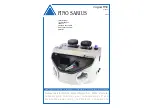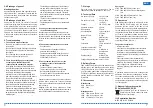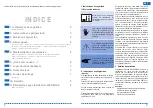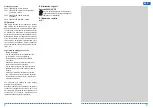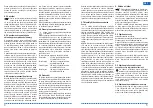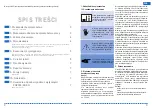
4.6 Blasting
After the blasting tank has been filled according to
specifications and has been closed select the desi-
red operation pressure between 2 and 6 bar with the
compressed air regulator, which is located on the
right side. Therefore pull the knob up and turn it to
the right to increase the operation pressure and to
the left to decrease it. Thereafter push compressed
air regulator down again. The pressure selection is
simultaneously valid for all blasting tanks.
Switch the unit on using the on/off switch on the
right side. Switch on your extraction. Select the
desired blasting tank with the selector inside the
blasting chamber. The colour-coding of the blasting
nozzle and the blasting tank match when the unit is
delivered. Actuating the foot switch starts the blas-
ting process. Quickly check the proper flow of the
blasting agent. Therefore aim on the black resin
inside the blasting chamber, which is designed for
this purpose. Avoid direct blasting on the inside
walls or the glass pane.
4.7 Installation of supplementary tank
Note:
For the installation of the supplementary tank
it is positively necessary to disconnect the
unit from mains and the compressed air supply.
All compressed air hoses of the FINO SARIUS Fine
Blasting Unit are connected with quick-couplings.
You can disconnect the quick-coupling by pushing
the outer ring of the quick-coupling inward and
simultaneously pulling the hose out. For the con-
nection of the compressed air hose it is only neces-
sary to pull it into the quick-coupling.
Firstly exchange the black resin caps in the blasting
chamber for the included hose leads. Now remove
the dummy covers from the compressed air distribu-
tor on the rear side. Subsequently install the supple-
mentary tank with the included screws. The two
longer screws are meant for the attachment sites at
the edge of the blasting unit. Connect the compres-
sed air hose of the supplementary tank to the free
connector of the compressed air distributor. Make
sure that the colour of the supplementary tank mat-
ches the marking of the blasting tank selector.
Remove the hose with the blasting nozzle from the
supplementary tank and guide it from the inside of
the blasting chamber through the hose lead and
reconnect it to the supplementary tank.
Finally insert the bleed air hose of the blasting tank
through the second hose lead into the inside of the
blasting chamber. Again check the firm and correct
fit of all compressed air hoses and reconnect the
blasting unit to the mains and compressed air
supply.
5. Maintenance and cleaning
For all cleaning and maintenance procedures dis-
connect the unit from the mains and compressed air
supply. Clean the unit with a slightly moist cloth. Do
not use any solvents for cleaning. These could affect
the resins and may lead to leakages and discol-
orations of the surfaces. The blasting tanks and lids
of the blasting tanks should only cleaned dryly.
To clean the chamber of the fine blasting unit a part
of the bottom grid can be removed. Therefore you
will find a small handle on the left side of the bottom
grid that is used to remove the bottom grid. Now you
can vacuum the unit.
5.1 Exchange of tube
Unplug from the socket. Do not press or bend the
tube during installation or removal. The tube might
break. For the exchange of the tube inside the blas-
ting chamber firstly open the chamber lid. Now
remove the black thumbscrew directly below the
chamber lid. Hereby the transparent tube cover
inside the blasting chamber comes loose. You can
now pull the tube from the sockets and replace it
with a new one. Afterwards attach the tube cover
again.
5.2 Exchange of air filter in the
blasting tank
Open the blasting tank. Now remove the riser using
a flat screwdriver or a small coin. Now you can
un screw the air filter by hand.
5.3 Exchange of blasting nozzles
Use only genuine spare parts.
To exchange the blasting nozzles unscrew
the colour-coded frontal cap from the blas-
ting handle and remove the blasting nozzle from the
cap. Put a new blasting nozzle in and screw the cap
back on the blasting handle. Make sure that the new
blasting nozzle has the same diameter than the
original one and that the black sealing ring is
present.
5
ENU
4. Processing Instructions
4.1 Getting started
Each time the unit is started its operational
safety has to be checked.
This includes in particular the soundness of
the power cable and the compressed air
supply as well as all compressed air hoses of the
blasting tanks and inside the blasting chamber.
Check the tight fit of the lids of the blasting tanks.
Check the water separator at the pressure reduction
valve and release the condensed water if necessary.
Should you observe any defects of the unit disconti-
nue operation and take care that it cannot be put
back into operation. The unit should be repaired
through an authorised service centre.
4.2 Place of installation
Choose a place for the fine blasting unit
that is stable, even and some distance from
sources of vibration and heat. The place should not
be exposed to large temperature changes. This
could induce the accumulation of moisture in the
blasting agent, which might lead to clogging of the
blasting agent and might interfere with the function
of the unit. Make sure that the basting tanks are
tightly sealed and sound.
4.3 Application of protective foil on the
pane of blasting chamber
For additional protection a protective foil may be
applied to the inside of the silicone-coated pane of
the blasting chamber. Make sure that conditions are
kept very clean. Embedded dust may later lead to
the formation of air bubbles between pane and
protective foil, which might impair vision into the
blasting chamber.
For simple and precise application of the protective
foil we recommend the disassembly of the pane of
the blasting chamber as described under section 4.7
Clean the inside of the pane and the adhesive side of
the protective foil thoroughly with a micro-fibre
cloth. Remove the cover from the two adhesive tapes
on the protective foil and apply them approx. 1 cm
from the longer edge of the glass pane. Thereby hold
the other end of the protective foil with some
distance from the glass pane. Attach the remainder
of theprotective foil bit by bit evenly to the glass
pane using a dry cloth.
4.4 Connection of the fine blasting unit
Connect the included compressed air hose to the
quick-coupling on the rear side of the unit and sub-
sequently connect to the compressed air supply. The
compressor should generate an operation pressure
of 7 bar and an air output of 100 litres / minute. Now
connect the foot switch to the provided connector on
the right side of the unit. An extraction can be con-
nected to the connector on the left side of the unit
and if necessary the included elbow might be used.
Check the voltage given on the type label of the unit
and make sure it corresponds with your mains supply
and connect the unit to a grounded socket. Should
your extraction have an automatic switch-on for
electrical appliances connect the fine blasting unit
to it. This has the advantage that the extraction is
automatically started when the blasting chamber
illumination is switched on. Make sure that all cables
and hoses are placed safely without being bent and
that there is no risk of stumbling.
The unit comes with two blasting tanks ready-to-use.
The installation of additional blasting tanks is descri-
bed under section 4.7.
4.5 Filling of blasting tanks
Do never operate the foot switch during the
refilling process.
Refill the blasting tank to a maximum of 75% of the
tank volume. Make sure that no blasting agent falls
into the riser in the tank. This could cause malfunc-
tions. Before you close the blasting tank make sure
that there is no blasting agent in the threads of the
blasting tank and the lid. This might lead to an early
wear of the individual components. Put on the lid of
the blasting tank properly and close it firmly.
The nozzles come from the manufacturer with the
following diameters:
Yellow nozzle
0,75 mm for blasting agent
up to 0,75 μm grain size
Green nozzle
1,00 mm for blasting agent
up to 150 μm grain size
Red nozzle
1,25 mm for blasting agent
up to 250 μm grain size
Blue nozzle
1,00 mm for blasting agent
up to 150 μm grain size
4

